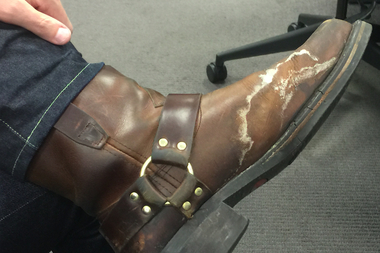As temperatures rise and snow piles melt, New Yorkers should expect to trudge through slush a-plenty over the next few days.
The far-from-ideal sidewalk conditions are bound to take a toll on our moods — and our shoes.
We consulted shoe repairman Michael Papoutsakis, of Pavlos Shoe Repair on the Upper East Side, on what to do when your footwear exhibits the classic symptoms of winter salt dispersal: the rough, crystalline stains and their chalky jagged borders.
Follow the steps below to fight the white shoe blight.
Step 1: Get the salt off.
You'll first need to apply a salt-stain remover to neutralize and clear away the salt that's eating through your shoe leather. Papoutsakis recommends removers sold by Meltonian, a shoe care products company owned by Kiwi, and the leather footwear care and horse care products company Feibing's. They work on all kinds of fabrics, including Gore-Tex.
Applying saddle soap, which contains mild soap and wax, is another option. If you're the DIY type, you can make it at home from ingredients purchased at your hardware and grocery stores.
The easiest home remedy for salt stains is a combination of water and white vinegar. You'll get different recommendations as to the proportions of those ingredients. You could mix equal parts water and vinegar. Or you go for a 2:1 or 3:1 water-to-vinegar solution, depending on how much salt you're removing.
Dab the vinegar mixture on your leather shoe with a soft cloth, rag, cotton ball or a paper towel. Start at the outer edges of the salt stain and work your way in. Then take a dampened clean cloth, and apply it to the stain to remove excess vinegar. Absorb the extra water with a dry cloth.
A word of advice from Papoutsakis before you choose your cleaner: "All these products you got to test, because there's so many types of leather available ... Don't just go right in the middle of your shoe, the top toe box and apply the product. You should be testing it on the back, on some inconspicuous spot."
Step 2: Condition the leather or suede.
After cleaning your shoes and drying them out, it's a good idea to re-condition them. A conditioner such as mink oil keeps the leather supple and water-resistant if you rub it on with a cloth and then let everything dry for at least 20 minutes.
As for brands, Papoutsakis suggests Lexol, which sells all kinds of leather care products.
Step 3: Polish!
Besides keeping your shoes looking spiffy, a good shoe polish helps moisturize and waterproof them. Experts say you should use a brush to remove all the salt and debris off your shoes first. Then dip a cloth in the polish and rub the cloth in small circles on the shoe leather. Use the shoe brush to remove the extra polish, and, finally, buff your shoe with your cloth until it shines like the top of the Chrysler Building.
Step 4: Waterproof your shoes to prevent future stains.
The best way to protect your shoes from the ravages of winter salt is to take preventative measures, Papoutsakis said.
Products with a beeswax-based formula, like Sno-Seal, dry after application into a solid wax that stays affixed to the leather's surface. Before rubbing Sno-Seal onto your shoes, the manufacturer recommends pre-heating them near a sunny window or with a hair dryer.
"It should keep off the salt, and it doesn't affect the leather in any negative way," the shoe repairman said. "It does a really decent job."
As for waterproofing suede shoes, there's always a risk of darkening the leather or flattening its texture. Sprays like Collonil's Classic Waterstop can do the trick. You should spray your shoes evenly four to six times, letting them dry for a few minutes between each coat, according to Men's Journal. Terrago also makes a reliable waterproofing spray that can be used on all kinds of materials.
"You should definitely spray your stuff," Papoutsakis said. "We spend so much on our shoes nowadays, you got to protect your footwear."


























